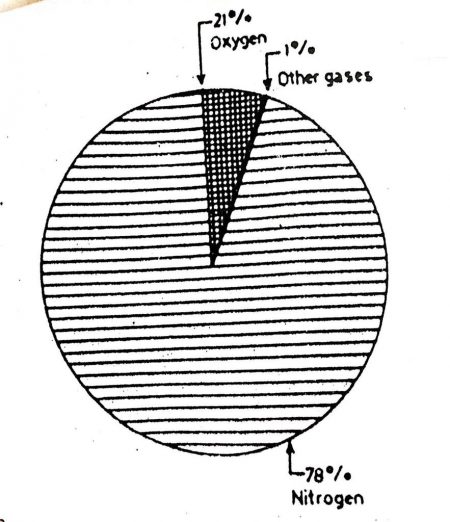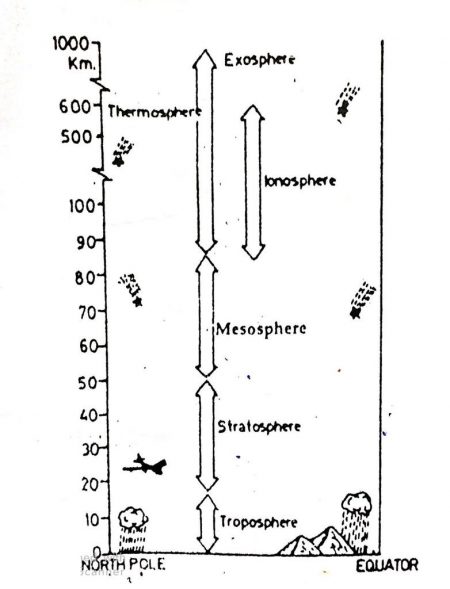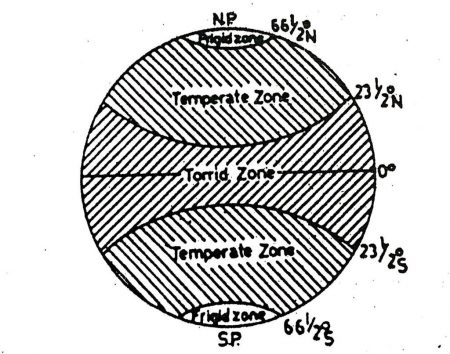The Atmosphere and its Temperature 01/06/2019 – Posted in: NCERT
THE ATMOSPHERE AND ITS TEMPERATURE
| TERMS YOU MUST KNOW
Atmosphere: The Air envelope consisting of gases that surrounds the earth. Troposphere: Lowest layer of the atmosphere where all weather phenomena take place. Insolation: Incoming Solar radiation received at the surface of the earth. Temperature: The degree of hotness or coldness of the air is known as Temperature. |
Our earth is surrounded by a vast envelope of air known as the ATMOSPHERE. It is held to the earth’s surface by its gravity. The air is composed of tiny molecules of gases. A MOLECULE is the smallest particle of a substance.
These molecules move randomly in all directions in the air. The number molecules present in a unit/volume determines the density of air. The number of molecules present in the air is very high near the surface of the earth.
Therefore, the density of atmosphere is high near the surface. As we go high up in the atmosphere, the molecules are spread farther apart. The air, therefore, become rarer.
Composition of air
Air is a mixture of different gases in varying proportions. There are two main gases in the air. They are nitrogen (78 per cent) and oxygen (21 per cent). The remaining one per cent in shared by argon, carbon dioxide, ozone, water vapour and many other gases.
Layers of the atmosphere
The atmosphere may broadly be divided into four layers. They are:
- Troposphere
- Stratosphere
- Mesosphere
- Thermosphere
However, there are no sharp boundaries between them.
Significance of Troposphere
The lowest layer of the atmosphere is called a TROPOSPHERE. It extends up to a height of 10-15 kilometers. It is the densest part of the atmosphere and contains large parts of the gases in the atmosphere. Almost all dust particles and water vapour of the atmosphere are found in this layer. Hence, all the weather phenomena take place here.
The troposphere and the layers above it Act as a filter. They allow the solar heat to reach the earth’s surface but absorb and reflect the harmful radiations present in sunlight. Hence, this layer is of great significance to us.
How the atmosphere is heated
The sun is the main source of the heat for our planet – earth. It constantly RADIATES (gives out) light and heat in all directions. This is called SOLAR RADITIONS. Only a small amount of this radiation is received by the earth because it is very far from the sun and is small too. The amount of SOLAR RADITION received by the earth is called INSOLATION (incoming solar radiation).
The earth’s surface is hearted mainly by insolating. The rays of the sun pass through the earth’s atmosphere, but they do not heat the air as much as they heat the earth’s surface.
Distribution of temperature and the heat zones
The distribution of temperature over the earth’s surface is closely linked with the amount of insolation received by it. In general, temperature decreases from the equator to the poles. Three heat zones may be identified on the earth’s surface.
Torrid Zone
The zone between 23 Degree 30’ North and 23 Degree 30’ South latitudes is known as the TORRID OF TROPICAL zone. The apparent movement of the sun during a year is between these two latitudes. As a result, the sun’s rays are almost vertical in this zone receives maximum insolation and is very hot.
Frigid Zone
The zones between 66 Degree 30’ North latitude and the North Pole and 66 Degree 30’ South latitude and the South Pole receive minimum insolation. They are known as the FRIGID ZONES.
Temperate Zone
The areas between the torrid zone, on the one hand, and the frigid zone on the other, have moderate temperature i.e. they are neither too hot nor too cold. They are called TEMPERATE ZONES.
|
During summer when land gets heated, the air above it also gets heated and rises. In contrast, the air above water is cooler and denser. It, therefore, moves towards the land and brings a cooling effect on the land the Sea. Thus there is very little difference between summer and winter temperatures in places near the sea. Such places, having equable temperature, are said to have MARITIME CLIMATE.
On the other hand, there is greater difference in summer and winter temperatures in places in the interior of a landmass. Such places having extremes of temperature are said to have CONTINENTAL CLIMATE.
Source: NCERT
You can follow us on LinkedIn and for more updates related to UPSC IAS Preparation, Like our Facebook Page and subscribe our Diligent IAS Youtube Channel
Also Read Related NCERTs Topics
- OUR SOLAR SYSTEM AND EARTH (Solar system, Sun, Asteroids, Eart, Satellite, Moon, Universe)
- LONGITUDE AND LATITUDE (Parallels of Latitude, Heat Zone of Earth, Longitude and Time, GMT and IST)
- MOTIONS OF THE EARTH (Rotation, Revolution, Cycle of the seasons)



